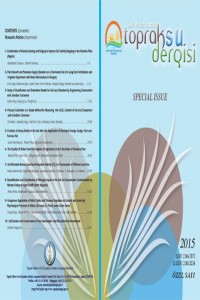Pressure calcimeter as a simple method for measuring the CaCO3 content of soil and comparison with Scheibler calcimeter
Abstract
A pressure calcimeter was made as an alternative to Scheibler calcimeter which is the conventional method
of soil CaCO3 content analyses. Since the measurement of CaCO3 content of soil with Scheibler calcimeter is
a slow and labor intensive method, the accuracy and presicion of the results are based on labor experience.
The pressure calcimeter gives fast and accurate results by eliminating these disadvantages. The measurement
of CaCO3 by pressure calcimeter, as in Scheibler, is done by measuring pressure of CO2 gas produced from
reaction of soil with HCl. The gas pressure, formed by the chemical reaction in a gasproof chamber was
measured by a digital manometer on the cap. The results were converted to % CaCO3 by calculations.
Excellent correlation (R2=0,998) was obtained in calibration carried out with pure CaCO3. 46 soil samples
contain CaCO3 between % 1–30 were analysed by Scheibler calcimeter and the results were compared with
pressure calcimeter. It can be concluded that pressure calcimeter has given satisfactory results and can be
used as an alternative to conventional Scheibler calcimeter in soil CaCO3 content analysis.
Keywords
References
- Horvath, B., Opara-Nadi, O., Beese, F., 2005. A simple method for measuring the carbonate content of soil. Soil Sci. Soc. Am. J. 69, 1066-1068.
- Kacar, B., 2012. Toprak Analizleri. Nobel Akademik
- Yayıncılık Eğitim Danışmanlık Tic. Ltd. Şti., Ankara. 43-53.
- Loeppert, R.H., Suarez, D.L., 1996. Carbonate and gypsum. 437—475.In D.L. Sparks et al. (ed.) Methods of soil analysis: Part 3—Chemical methods. SSSA Book Ser. No. 5. SSSA and ASA Madison, WI.
- Martin, A.E., Reeve, R., 1954. A rapid manometric method for determining soil carbonate. Soil Sci. 79, 187—197.
- Wagner, S.C., Hanson, D.J., Olness, A., Voorhess, W.B., 1998. A volumetric inorganic carbon analysis system. Soil Sci. Soc. Am. J. 62:690—693.
- Williams, DE., 1948. A rapid manometer method for the determination of carbonate in soils. Soil. Sci. Soc. Am. Proc. 13:127—129.
- Woodward, L., 1961. A manometric method for the rapid determination of lime in soils. Soil Sci. Soc. Am. Proc. 25, 248—250. I28
Pressure calcimeter as a simple method for measuring the CaCO3 content of soil and comparison with Scheibler calcimeter
Abstract
A pressure calcimeter was made as an alternative to Scheibler calcimeter which is the conventional method
of soil CaCO3 content analyses. Since the measurement of CaCO3 content of soil with Scheibler calcimeter is
a slow and labor intensive method, the accuracy and presicion of the results are based on labor experience.
The pressure calcimeter gives fast and accurate results by eliminating these disadvantages. The measurement
of CaCO3 by pressure calcimeter, as in Scheibler, is done by measuring pressure of CO2 gas produced from
reaction of soil with HCl. The gas pressure, formed by the chemical reaction in a gasproof chamber was
measured by a digital manometer on the cap. The results were converted to % CaCO3 by calculations.
Excellent correlation (R2=0,998) was obtained in calibration carried out with pure CaCO3. 46 soil samples
contain CaCO3 between % 1–30 were analysed by Scheibler calcimeter and the results were compared with
pressure calcimeter. It can be concluded that pressure calcimeter has given satisfactory results and can be
used as an alternative to conventional Scheibler calcimeter in soil CaCO3 content analysis.
References
- Horvath, B., Opara-Nadi, O., Beese, F., 2005. A simple method for measuring the carbonate content of soil. Soil Sci. Soc. Am. J. 69, 1066-1068.
- Kacar, B., 2012. Toprak Analizleri. Nobel Akademik
- Yayıncılık Eğitim Danışmanlık Tic. Ltd. Şti., Ankara. 43-53.
- Loeppert, R.H., Suarez, D.L., 1996. Carbonate and gypsum. 437—475.In D.L. Sparks et al. (ed.) Methods of soil analysis: Part 3—Chemical methods. SSSA Book Ser. No. 5. SSSA and ASA Madison, WI.
- Martin, A.E., Reeve, R., 1954. A rapid manometric method for determining soil carbonate. Soil Sci. 79, 187—197.
- Wagner, S.C., Hanson, D.J., Olness, A., Voorhess, W.B., 1998. A volumetric inorganic carbon analysis system. Soil Sci. Soc. Am. J. 62:690—693.
- Williams, DE., 1948. A rapid manometer method for the determination of carbonate in soils. Soil. Sci. Soc. Am. Proc. 13:127—129.
- Woodward, L., 1961. A manometric method for the rapid determination of lime in soils. Soil Sci. Soc. Am. Proc. 25, 248—250. I28
Details
| Primary Language | English |
|---|---|
| Journal Section | Articles |
| Authors | |
| Publication Date | January 31, 2015 |
| Published in Issue | Year 2015 Special Issue |
Cite
Cited By
INVESTIGATION OF THE USE OF CALCIUM CARBONATE AS NANOPARTICLES IN NUCLEAR REACTORS
Konya Journal of Engineering Sciences
https://doi.org/10.36306/konjes.1139083
Assessing and Predicting Soil Quality in Heavy Metal-Contaminated Soils: Statistical and ANN-Based Techniques
Journal of Soil Science and Plant Nutrition
https://doi.org/10.1007/s42729-023-01507-w
Trophic transfer of heavy metals across a food chain in a wastewater-irrigated agroecosystem
Environmental Monitoring and Assessment
https://doi.org/10.1007/s10661-024-13179-9
Grafik Tasarım : Filiz ERYILMAZ
Basım Yeri : Gıda Tarım ve Hayvancılık Bakanlığı - Eğitim Yayım ve Yayınlar Dairesi Başkanlığı
İvedik Caddesi Bankacılar Sokak No : 10 Yenimahalle, Ankara Türkiye

